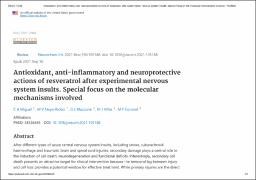| dc.description.abstract | Abstract
After different types of acute central nervous system insults, including stroke, subarachnoid haemorrhage and traumatic brain and spinal cord injuries, secondary damage plays a central role in the induction of cell death, neurodegeneration and functional deficits. Interestingly, secondary cell death presents an attractive target for clinical intervention because the temporal lag between injury and cell loss provides a potential window for effective treatment. While primary injuries are the direct result of the precipitating insult, secondary damage involves the activation of pathological cascades through which endogenous factors can exacerbate initial tissue damage. Secondary processes, usually interactive and overlapping, include oxidative stress, neuroinflammation and dysregulation of autophagy, ultimately leading to cell death. Resveratrol, a natural stilbene present at relatively high concentrations in grape skin and red wine, exerts a wide range of beneficial health effects. Within the central nervous system, in addition to its inherent free radical scavenging role, resveratrol increases endogenous cellular antioxidant defences thus modulating multiple synergistic pathways responsible for its antioxidant, anti-inflammatory and anti-apoptotic properties. During the last years, a growing body of in vitro and in vivo evidence has been built, indicating that resveratrol can induce a neuroprotective state and attenuate functional deficits when administered acutely after an experimental injury to the central nervous system. In this review, we summarize the most recent findings on the molecular pathways involved in the neuroprotective effects of this multi target polyphenol, and discuss its neuroprotective potential after brain or spinal cord injuries.
Keywords: Autophagy; Motor impairment; Neuroinflammation; Neuropathic pain; Oxidative damage; Resveratrol.
Copyright © 2021 Elsevier Ltd. All rights reserved. | es |


